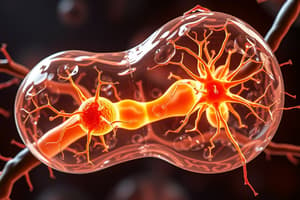Podcast
Questions and Answers
Where does glycolysis occur and where does the citric acid cycle take place?
Where does glycolysis occur and where does the citric acid cycle take place?
- Glycolysis occurs in the cytoplasm and the citric acid cycle takes place in the mitochondria (correct)
- Both occur in the cytoplasm
- Both occur in the mitochondria
- Glycolysis occurs in the mitochondria and the citric acid cycle takes place in the cytoplasm
What is the fate of pyruvate after glycolysis?
What is the fate of pyruvate after glycolysis?
- It is converted into glucose
- It is converted into fatty acids
- It is oxidatively decarboxylated by the pyruvate dehydrogenase complex to form acetyl CoA (correct)
- It is transported out of the cell
What are the catalytic coenzymes required for the synthesis of acetyl Coenzyme A from pyruvate?
What are the catalytic coenzymes required for the synthesis of acetyl Coenzyme A from pyruvate?
- Thiamine pyrophosphate (TPP), lipoic acid, and flavin adenine dinucleotide (FAD) (correct)
- CoA and nicotinamide adenine dinucleotide
- Only CoA
- Only nicotinamide adenine dinucleotide
Which of the following is NOT true regarding the synthesis of acetyl Coenzyme A from pyruvate?
Which of the following is NOT true regarding the synthesis of acetyl Coenzyme A from pyruvate?
What is the fate of the carbon atoms of carbohydrates after the conversion of pyruvate into acetyl CoA?
What is the fate of the carbon atoms of carbohydrates after the conversion of pyruvate into acetyl CoA?
Which of the following is true regarding the pyruvate dehydrogenase complex?
Which of the following is true regarding the pyruvate dehydrogenase complex?
Which of the following is true about the pyruvate dehydrogenase complex?
Which of the following is true about the pyruvate dehydrogenase complex?
Which coenzymes serve as catalytic coenzymes during the conversion of pyruvate into acetyl CoA?
Which coenzymes serve as catalytic coenzymes during the conversion of pyruvate into acetyl CoA?
What happens to the carbon atoms of carbohydrates after the conversion of pyruvate into acetyl CoA?
What happens to the carbon atoms of carbohydrates after the conversion of pyruvate into acetyl CoA?
Flashcards are hidden until you start studying
Study Notes
The Link Between Glycolysis and the Citric Acid Cycle
- Glycolysis occurs in the cytoplasm of the cell while the citric acid cycle takes place in the mitochondria.
- Pyruvate, a product of glycolysis, must be transported into the mitochondria for aerobic metabolism.
- In the mitochondrial matrix, pyruvate is oxidatively decarboxylated by the pyruvate dehydrogenase complex to form acetyl CoA.
- The conversion of pyruvate into acetyl CoA is irreversible and commits carbon atoms to oxidation by the citric acid cycle.
- The pyruvate dehydrogenase complex produces high-transfer-potential electrons in the form of NADH.
- Fatty acid degradation is another source of acetyl CoA for the citric acid cycle.
- The pyruvate dehydrogenase complex is a large, highly integrated complex of three distinct enzymes with its own active site.
- The complex is a member of a family of extremely large similar complexes with molecular masses ranging from 4 million to 10 million daltons.
- The synthesis of acetyl Coenzyme A from pyruvate requires three enzymes and five coenzymes.
- The reaction requires the participation of catalytic coenzymes, such as thiamine pyrophosphate (TPP), lipoic acid, and flavin adenine dinucleotide (FAD), and stoichiometric coenzymes, such as CoA and nicotinamide adenine dinucleotide.
- The conversion of pyruvate into acetyl CoA consists of three steps: decarboxylation, oxidation, and transfer of the resultant acetyl group to CoA.
- The steps must be coupled to preserve the free energy derived from the decarboxylation step to drive the formation of NADH and acetyl CoA.
The Mechanism of Acetyl Coenzyme A Synthesis from Pyruvate
- Glycolysis occurs in the cytoplasm of the cell, while the citric acid cycle occurs in mitochondria.
- Pyruvate is transported into mitochondria to be aerobically metabolized.
- Pyruvate is oxidatively decarboxylated by the pyruvate dehydrogenase complex to form acetyl CoA in the mitochondrial matrix.
- The conversion of pyruvate into acetyl CoA is irreversible and commits the carbon atoms of carbohydrates to oxidation by the citric acid cycle or to the synthesis of fatty acids.
- The pyruvate dehydrogenase complex produces and captures high-transfer-potential electrons in the form of NADH, foreshadowing the key features of the reactions of the citric acid cycle.
- Pyruvate produced by glycolysis is converted into acetyl CoA, the fuel of the citric acid cycle.
- The pyruvate dehydrogenase complex is a large, highly integrated complex of three distinct enzymes, each with its own active site.
- The pyruvate dehydrogenase complex is a member of a family of extremely large similar complexes with molecular masses ranging from 4 million to 10 million daltons.
- The synthesis of acetyl Coenzyme A from pyruvate requires three enzymes and five coenzymes.
- The conversion of pyruvate into acetyl CoA consists of three steps: decarboxylation, oxidation, and the transfer of the resultant acetyl group to CoA.
- The coenzymes thiamine pyrophosphate (TPP), lipoic acid, and flavin adenine dinucleotide (FAD) serve as catalytic coenzymes, and CoA and nicotinamide adenine dinucleotide are stoichiometric coenzymes.
- The mechanism of the pyruvate dehydrogenase reaction is wonderfully complex, requiring the participation of the three enzymes of the pyruvate dehydrogenase complex and five coenzymes.
Studying That Suits You
Use AI to generate personalized quizzes and flashcards to suit your learning preferences.




